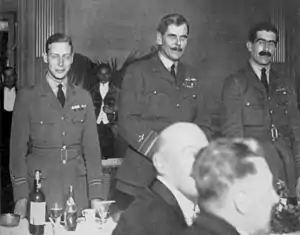Christopher Courtney
Air Chief Marshal Sir Christopher Lloyd Courtney, GBE, KCB, DSO (27 June 1890 – 22 October 1976) was a senior Royal Air Force officer.
Sir Christopher Lloyd Courtney | |
|---|---|
 Courtney (shown on right) with Trenchard and Prince Albert in 1919 | |
| Born | 27 June 1890 |
| Died | 22 October 1976 (aged 86) |
| Allegiance | United Kingdom |
| Service/ | Royal Navy (1905–18) Royal Air Force (1918–45) |
| Years of service | 1905–45 |
| Rank | Air Chief Marshal |
| Commands held | Air Member for Supply and Organisation (1940–45) Reserve Command (1939) British Forces in Iraq (1937–39) Deputy Chief of the Air Staff (1935–37) No. 2 (Indian) Wing (1920–24) Independent Air Force (1918) 11th Brigade (1918) No. 7 Squadron RNAS (1916–17) No. 4 Wing RNAS (1916) RNAS Dover (1915–16) No. 4 Squadron RNAS (1915) Killingholme Naval Air Station (1914–15) |
| Battles/wars | First World War Second World War |
| Awards | Knight Grand Cross of the Order of the British Empire Knight Commander of the Order of the Bath Distinguished Service Order Mentioned in Despatches Order of St. Anna, 3rd Class (Russia) Chevalier of the Legion of Honour (France) Commander of the Legion of Merit (United States) |
| Other work | Businessman |
RAF career
Courtney joined the Royal Navy in May 1905 as a midshipman at Britannia Naval College.[1] By late 1909 he was an acting sub-lieutenant on board HMS Commonwealth.[1]
He fought in the First World War initially as Officer Commanding Killingholme Royal Naval Air Station.[1] He continued his war service as Officer Commanding Royal Naval Air Station Dover, Officer Commanding No. 4 Wing RNAS and then Officer Commanding No. 7 Squadron RNAS.[1] In April 1918, with the creation of the Royal Air Force, Courtney transferred from the Navy to the RAF and at that time he was appointed Deputy Director of Aircraft Equipment at the newly established Air Ministry. Just before the end of World War I, Courtney was promoted to acting brigadier-general and sent France to command the 11th Brigade which was being established as a subordinate formation of the RAF's Independent Air Force. However, once the armistice was declared, the Independent Air Force's commander, Major-General Sir Hugh Trenchard, returned home and Courtney succeeded him as commander.[2]
After the war he served as Officer Commanding, No 2 (Indian) Wing and then after a tour on the Directing Staff at the RAF Staff College, Andover, he was appointed Deputy Director of Operations and Intelligence at the Air Ministry.[1] He briefly served as Air Officer Commanding RAF Iraq Command on a temporary basis in late 1932.[1] He was made Director of Training at the Air Ministry in 1933, Director of Staff Duties in 1934 and Deputy Chief of the Air Staff and Director of Operations & Intelligence in 1935.[1] After that he was appointed Air Officer Commanding RAF Iraq Command in 1937 and Air Officer Commanding-in-Chief Reserve Command in February 1939.[1] He became Air Member for Supply and Organisation in January 1940 and remained in that post throughout the remainder of the Second World War until he retired in 1945.[1]
References
- Air of Authority – A History of RAF Organisation – Air Chief Marshal Sir Christopher Courtney
- Richards, Denis (May 2008). "Courtney, Sir Christopher Lloyd". Oxford Dictionary of National Biography. Oxford University Press. Retrieved 10 November 2009.
External links
| Wikimedia Commons has media related to Christopher Courtney. |
- Liddell Hart Centre for Military Archives web page on Air Chief Marshal Sir Christopher Courtney.
| Military offices | ||
|---|---|---|
| Preceded by Sir Hugh Trenchard As Commander-in-Chief the Inter-Allied Independent Air Force |
General Officer Commanding the Independent Force 1918 |
Force disbanded |
| Preceded by Edgar Ludlow-Hewitt |
Air Officer Commanding Iraq Command Temporary appointment 1932 |
Succeeded by Charles Burnett |
| Preceded by Edgar Ludlow-Hewitt |
Deputy Chief of the Air Staff and Director of Operations and Intelligence 26 January 1935 – 25 January 1937 |
Succeeded by Richard Peirse |
| Preceded by William Mitchell |
Air Officer Commanding British Forces in Iraq 1937–1939 |
Succeeded by Harry Smart |
| Preceded by New post |
Air Officer Commanding-in-Chief Reserve Command February 1939 – August 1939 |
Succeeded by Sir John Steel |
| Preceded by William Welsh |
Air Member for Supply and Organisation 1940–1945 |
Succeeded by Sir Leslie Hollinghurst |